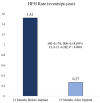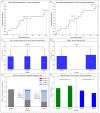Recent Advances in Remote Pulmonary Artery Pressure Monitoring for Patients with Chronic Heart Failure: Current Evidence and Future Perspectives
- PMID: 36772403
- PMCID: PMC9921931
- DOI: 10.3390/s23031364
Recent Advances in Remote Pulmonary Artery Pressure Monitoring for Patients with Chronic Heart Failure: Current Evidence and Future Perspectives
Abstract
Chronic heart failure (HF) is associated with high hospital admission rates and has an enormous burden on hospital resources worldwide. Ideally, detection of worsening HF in an early phase would allow physicians to intervene timely and proactively in order to prevent HF-related hospitalizations, a concept better known as remote hemodynamic monitoring. After years of research, remote monitoring of pulmonary artery pressures (PAP) has emerged as the most successful technique for ambulatory hemodynamic monitoring in HF patients to date. Currently, the CardioMEMS and Cordella HF systems have been tested for pulmonary artery pressure monitoring and the body of evidence has been growing rapidly over the past years. However, several ongoing studies are aiming to fill the gap in evidence that is still very clinically relevant, especially for the European setting. In this comprehensive review, we provide an overview of all available evidence for PAP monitoring as well as a detailed discussion of currently ongoing studies and future perspectives for this promising technique that is likely to impact HF care worldwide.
Keywords: CardioMEMS; Cordella; e-health; heart failure; hemodynamics; remote care; sensor; telemonitoring.
Conflict of interest statement
J.J.B. reports independent research grants from Abbott and speaker fees. P.R.D.C., D.A. and S.P.R. report no conflict of interest.
Figures








References
-
- Ambrosy A.P., Fonarow G.C., Butler J., Chioncel O., Greene S.J., Vaduganathan M., Nodari S., Lam C.S.P., Sato N., Shah A.N., et al. The global health and economic burden of hospitalizations for heart failure: Lessons learned from hospitalized heart failure registries. J. Am. Coll. Cardiol. 2014;63:1123–1133. doi: 10.1016/j.jacc.2013.11.053. - DOI - PubMed
-
- James S.L., Abate D., Abate K.H., Abay S.M., Abbafati C., Abbasi N., Abbastabar H., Abd-Allah F., Abdela J., Abdelalim A., et al. Global, regional, and national incidence, prevalence, and years lived with disability for 354 diseases and injuries for 195 countries and territories, 1990–2017: A systematic analysis for the Global Burden of Disease Study 2017. Lancet. 2018;392:1789–1858. - PMC - PubMed
-
- Heidenreich P.A., Bozkurt B., Aguilar D., Allen L.A., Byun J.J., Colvin M.M., Deswal A., Drazner M.H., Dunlay S.M., Evers L.R., et al. 2022 AHA/ACC/HFSA Guideline for the Management of Heart Failure: A Report of the American College of Cardiology/American Heart Association Joint Committee on Clinical Practice Guidelines. J. Am. Coll. Cardiol. 2022;79:e263–e421. - PubMed
-
- McDonagh T.A., Metra M., Adamo M., Gardner R.S., Baumbach A., Bohm M., Burri H., Butler J., Celutkiene J., Chioncel O., et al. 2021 ESC Guidelines for the diagnosis and treatment of acute and chronic heart failure. Eur. Heart J. 2021;42:3599–3726. - PubMed
Publication types
MeSH terms
LinkOut - more resources
Full Text Sources
Medical
Research Materials
Miscellaneous

